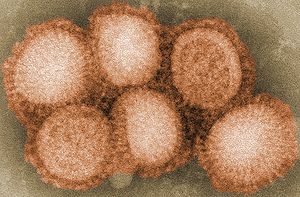
There may be a lot more vulnerability in the population to a new swine influenza virus than was first thought
There may be a lot more vulnerability in the population to a new swine influenza virus than was first thought, new Canadian research suggests.
It has been believed that while children and teens are probably vulnerable to the new H3N2 variant, people over the age of 20 or so would have antibodies that would either block infection or protect against severe disease caused by the viruses.
But the new study suggests that while young adults do have antibodies that recognize the viruses, antibody levels start to drop sharply in middle-aged adults. When plotted on a graph, the decline is striking and suggests that the elderly may also be unprotected against this new flu virus.
Whether that’s true or not remains to be shown. The study, published Thursday in the journal Eurosurveillance, only looked at blood samples from children 17 months to 10 years and adults aged 20 to 59.
But lead author Dr. Danuta Skowronski said the results suggest that if this new virus gets a foothold in humankind, it could sicken a lot more people than H1N1 viruses — which also came from swine — did during the 2009 pandemic.
Skowronski, an influenza expert with the British Columbia Centre for Disease Control in Vancouver, admitted the findings were a surprise.
“We had predicted that most adults would have some cross-reactive antibodies to the virus. But what we found was that young adults — those in the range 20 to 30 — did have antibodies to this swine H3N2. … But we saw a decrease with increasing age in adults — which for me is a concern,” she said in an interview.
The swine H3N2 viruses were once human viruses that entered pig populations sometime in the early to mid-1990s. Studies suggest the contemporary pig viruses are most similar to a human H3N2 that circulated around 1995.
So the thought has been that people born before then probably would have had exposure to ancestors of the swine H3N2 and would have some protection from it.
Skowronski said it would be important to do similar work looking for antibodies in seniors to verify whether, as she fears, they are also susceptible to the new virus. Her group is doing a study, but she hopes others will as well. Patterns of protection against this virus may vary by geographic areas, she suggested.
Her concern relates to two factors, one specific to H3N2 viruses and the other which is a feature of flu in general.
After decades of experience with H3N2 viruses — the human versions have been circulating since 1968 — public health officials know this flu subtype takes a harsh toll on seniors. “The elderly … don’t handle H3N2 viruses well at all,” Skowronski said.
And the notion of vulnerability in both children and seniors is a particular concern. It’s recognized that children ramp up flu activity in a community, and that activity generally makes its way to the elderly.
“If we have a mix of broad susceptibility to an emerging swine H3N2 virus in children — which our results suggest — and we have a susceptibility because of lack of pre-existing antibody in the elderly, who don’t handle H3N2 viruses well, that’s not a good mix,” Skowronski said.
“Children can propagate it and the elderly suffer the most severe consequences of H3N2 viruses.”
Dr. Michael Osterholm, director of the Center for Infectious Diseases Research and Policy at the University of Minnesota, said it is important to pursue this line of study to assess the risk these new H3N2 viruses might pose.
“This really deserves further study,” he said.
Bookmark this page for “swine flu virus” and check back regularly as these articles update on a frequent basis. The view is set to “news”. Try clicking on “video” and “2” for more articles.







